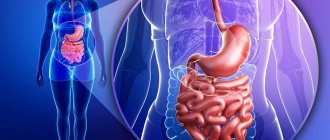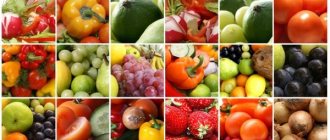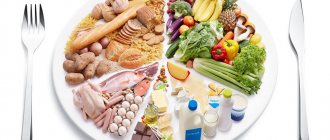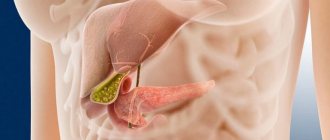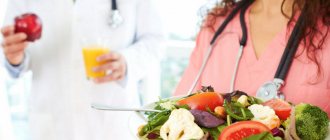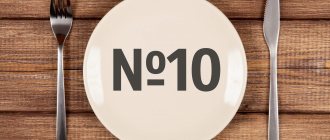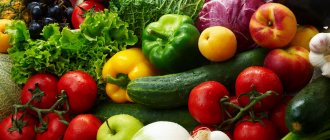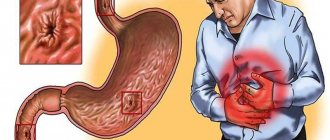Diet 4, developed by the therapist and founder of the Institute of Nutrition in Moscow Manuil Pevzner, at the beginning of the 20th century helped many people get rid of problems associated with the functioning of the gastrointestinal tract. It was and is prescribed in sanatoriums, hospitals and treatment centers as a remedy for various disorders of the digestive system, including diarrhea, colitis and intestinal tuberculosis.
General rules
This type of diet is prescribed to patients during the treatment of digestive system disorders and intestinal pathologies accompanied by diarrhea. Its main task is to eliminate the pathological processes accompanying these diseases.
The diet completely excludes dishes that can stimulate the secretory functions of the stomach and activate the functioning of the gallbladder. Heat treatment involves cooking and steam cooking. Dishes are served in liquid, semi-liquid and pureed form.
General dietary rules:
- six meals a day;
- preparation of products is allowed only by boiling and steaming;
- Solid foods, thick, hot and cold foods are completely prohibited.
https://youtu.be/xkjFTzkA-Lw
The essence of the diet
Table 4c according to Pevzner purposefully provides balanced nutrition with complete absorption in case of insufficient intestinal functioning. Nutrition allows you to smoothly restore the impaired functions of the digestive organs and transfer the patient to a normal diet.
Therapeutic nutrition according to Pevzner has a positive effect on digestion and intestinal motility. Also, table No. 4c, literally in the first days of following it, will reduce bloating and flatulence, and within a week of rational nutrition, bowel regularity will normalize.
The total energy value ranges from 3000-35000 calories.
The chemical composition of the diet is balanced:
- Carbohydrates – at least 400 grams;
- Proteins – 120 grams (40% plant-based);
- Fats – 100 grams (75-80% animal origin);
- The level of salt consumed is 10 grams;
- The daily fluid intake is 1.5-2 liters.
The duration of the diet is determined by the attending physician. As a rule, it lasts 1-3 weeks, after which the patient is transferred to table No. 15 or a normal healthy diet.
Diet types #4
Table No. 4 is divided into three subtypes - 4A, 4B, 4B. The main difference is the food set.
Diet 4A
This therapeutic nutrition option is prescribed in the acute period of the disease. The diet menu is monotonous and excludes many foods. It is recommended to be observed for two to five days. Energy value – 1600 Kcal.
Diet 4B
Table 4B is prescribed during the period of exacerbation of chronic gastrointestinal pathologies - for diseases of the liver, kidneys, biliary tract, pancreas. Table 4B is physiologically complete, so it can be practiced for a long time. Energy value – 2900 Kcal.
Diet 4B
The diet is practiced during the first 7 days after surgery, as well as after the end of the acute period of intestinal disease. Used as a transition from the treatment table to the general one. Energy value – 3140 Kcal.
General characteristics of the diet
This technique was formed back in 1929 by the Soviet therapist M.I. Pevzner. This man was the discoverer of the foundations of diet therapy in domestic science. He created about 15 areas of therapeutic nutritional regimens (potassium, magnesium, anti-inflammatory, hyposensitizing). Treatment tables were integrated not only into the lives of citizens of the union, but also into the diet of sanatorium-resort systems. People experiencing symptoms of rheumatism, hypertension, tuberculosis, atherosclerosis, heart disease and other organ diseases adhered to the established nutritional system. What is the secret of the Pevzner diet tables? It's quite simple! Rational selection of products, optimal cooking process (food processing technology) and frequency of food consumption. Thus, you can effectively overcome intestinal disorders and not suffer for a whole week.
The fundamental indications for the use of a dietary table (table No. 4 according to Pevzner) are diarrhea of any direction (including constipation). In the lion's share of cases, this concerns acute diseases of a chronic nature, namely: dysentery, gastroenteritis (at the time of significant exacerbation), colitis during the period of maximum activity. Indeed, in parallel with food intake, a massive amount of potentially fermenting and decaying elements penetrates inside a person. If there are a lot of such substances, then the medicines will not be able to help the patient much. Therefore, you should not neglect the “Table No. 4” nutrition plan.
The diet is quite effective both for severe infectious diseases and for simple food poisoning from low-quality products. This also applies when a person experiences long-term constipation.
Allowed food basket
The list of products approved by nutritionists for use when developing a daily menu is quite extensive. It is represented by the following positions:
- Already dried (day before yesterday) wheat bread, homemade crackers. The permissible norm for 24 hours is no more than 200 grams of product. Additionally, dry cookies (biscuits) are allowed.
- Puree porridge. They are the basis of the patient’s diet. Semolina, white rice, buckwheat, and oatmeal are allowed. They are prepared either in water or in fat-free (skimmed) meat broth.
- Butter. Use only 50 grams per day.
- Soups. When cooking, you need to take the removed (second) one from under the fish/meat. To fill, take cereals, a minimum of vegetables, pureed or processed with a blender/meat grinder, boiled meat, dumplings, eggs, meatballs.
- Meat. Only dietary varieties are allowed - veal, beef, chicken breast, turkey, rabbits. Before cooking, the skin must be removed and the tendons cut out.
- Steamed cutlets, meatballs, quenelles. When collecting minced meat, bread must be replaced with semolina or boiled rice. It is allowed to prepare meat pate by adding a minimum amount of salt.
- Low-fat fish. Serving in the form of a whole boiled/steamed piece is allowed. If it is a chopped version, then it can be dumplings, cutlets, meatballs. Cooking or steam cooking is allowed.
- Eggs. The norm is 2 pieces per day. Served soft-boiled, in the form of a steam omelette. It is allowed to be mixed into soups (you get hearty egg flakes) and soufflés.
- Low-fat pureed cottage cheese. Used for making casseroles and soufflés.
- Vegetables. It is allowed to be used exclusively in pureed form, adding a small amount when cooking soup. The volumes are minimal.
- Fruits - apples (fresh, in the form of puree), jelly (blueberries, bird cherry, dogwood, quince, pears), fruit drinks.
- Juices from sweet berries (previously diluted with boiled water in equal proportions). Grape, plum and apricot fruits are prohibited.
As a drink, it is allowed to use: herbal teas, rosehip uzvar, infusion of bird cherry berries, tea (green or black varieties), still water (no more than 1.5 liters per day).
What you can eat - list of recommended foods
- Bread and bakery products. Rusks from the highest grades of white bread, thinly sliced, only dried.
- Soups prepared in a weak low-fat meat or fish broth with the addition of mucous infusions, steamed or boiled meat or fish dumplings, meatballs, egg flakes, boiled and pureed meat. The meat is added together with the mucous broth.
- Meat and fish dishes. Steamed or boiled in water meat and fish cutlets, dumplings, meatballs, soufflé from boiled meat or fish. For cooking, meat should be low-fat, without fascia and tendons (beef, chicken, turkey, rabbit, skinless poultry). Minced meat is passed through a fine grinder 3-4 times. Fish is allowed only low-fat varieties, without skin (pollock, haddock, cod, pike perch, pike, carp, etc.).
- Porridges and side dishes. Puree porridges in water or low-fat meat broth: rice, oatmeal, buckwheat, semolina. All legumes and pasta are excluded, except noodles.
- Egg dishes. Eggs in limited quantities. If well tolerated, it is allowed to eat soft-boiled eggs and in the form of steam omelettes, no more than 2 pieces per day.
- Sweet dishes, sweets, fruits, berries. Sugar up to 40 g per day, jelly, jelly from blueberries, bird cherry, ripe sweet pears, apples, quince.
- Milk and dairy products. Freshly prepared cottage cheese, precipitated with calcium or kefir salts, natural or in the form of a steam soufflé. All other dairy products are excluded.
- Beverages. Tea, black coffee, water cocoa, rosehip, blueberry, bird cherry decoction.
- Fats. Butter, in limited quantities (do not fry, add 5 g per serving to prepared dishes).
Prohibited Products
Table No. 4 completely excludes the consumption of foods containing fiber.
The list of prohibited products includes:
- Vegetables. They can be added to soups in small quantities and pureed.
- Bread. Whole grain, rye, bran, cereal. It is difficult to digest and can injure the mucous membrane.
- Fresh pastries, pancakes/pancakes. They provoke the processes of fermentation and rotting.
- Jam, honey, jam, dried fruits, sweets. During the day you are allowed to use 50 grams of granulated sugar.
- Porridge – millet, barley, barley, legumes.
- Pasta.
- Fatty broths. They contribute to increased intestinal motility and worsening of the condition.
- Fatty meats and fish.
- Canned food, pickles and fish in particular.
- Whole milk, cream, sour cream, cheese. May cause increased diarrhea. Milk must be diluted with water. It is used only for cooking porridges and puddings.
- Cocoa, coffee with milk, sweet soda, kvass.
- Sauces, marinades.
- Smoked meats, ham, sausages.
What can't you eat?
The diet limits the consumption of fats and carbohydrates to the lower limit of the physiological norm.
- Products that have an irritating mechanical and chemical effect on the intestinal mucosa are excluded from the diet. Anything fried or baked is prohibited. All foods containing coarse dietary fiber should be excluded. In addition, foods containing acid should not be eaten. For example, citrus fruits and products with vinegar. Carbonated drinks also irritate the mucous membranes.
- Dishes made from foods that enhance the processes of fermentation and putrefaction in the intestines are also unacceptable on this diet. These products include legumes, large amounts of protein, sweets and flour.
- Products that stimulate increased bile secretion, gastric and pancreatic secretion, as well as substances that irritate the liver are also excluded.
- All sauces, spices, and snacks are excluded.
- All dishes are boiled or steamed. Products are accepted in ground form.
Sample weekly menu
It is necessary to organize six meals a day. Be sure to alternate dishes to avoid monotony.
Monday
1st breakfast: oatmeal with a piece of butter, a soft-boiled egg, a drink.
2nd breakfast: pureed apple (fresh or pre-cooked in the oven).
Lunch: soup with rice cereal and the addition of minced meatballs, homemade croutons, buckwheat with chicken cutlets (stewed in water or steamed), apple-pear drink.
Afternoon snack: jelly with biscuits or homemade croutons.
Dinner: semolina (without adding granulated sugar), a portion of boiled fish, a drink.
Late dinner: jelly.
Tuesday
1st breakfast: rice porridge (sweetened) with a piece of butter, crackers, rose hip broth.
2nd breakfast: a few spoons of cottage cheese.
Lunch: meat broth thickened with semolina, steamed dumplings of minced chicken/turkey, side dish - boiled rice, homemade croutons, jelly.
Afternoon snack: an apple baked in the oven and chopped in a blender.
Dinner: egg, buckwheat porridge, drink.
Late dinner: compote of allowed dried fruits with biscuits.
Wednesday
1st breakfast: thoroughly boiled oatmeal with a piece of butter, a pureed piece of boiled meat, a little cottage cheese, tea, biscuits.
2nd breakfast: fruit puree.
Lunch: chicken broth with rice cereal and egg flakes, grated buckwheat porridge, meatballs, fruit drink.
Afternoon snack: jelly with biscuits.
Dinner: minced fish meatballs (you can use hake), garnished with well-cooked rice, sweet black tea.
Late dinner: jelly.
Thursday
1st breakfast: buckwheat porridge with a piece of butter, a soft-boiled egg, a little cottage cheese, a fruit drink.
2nd breakfast: jelly with wheat bread dried in the oven.
Lunch: soup with meatballs, thickened with semolina, homemade croutons, thoroughly boiled rice cereal, garnished with steamed minced fish balls, jelly.
Afternoon snack: rosehip broth, homemade crackers.
Dinner: cottage cheese-buckwheat pudding, meat soufflé, drink.
Late dinner: pear broth.
Friday
1 breakfast: rice pudding, low-fat cottage cheese, tea,
2nd breakfast: berry broth.
Lunch: fish broth with fish balls and rice, homemade croutons, minced chicken cutlets (steamed), garnished with grated buckwheat, berry broth.
Afternoon snack: unsweetened decoction of rose hips with biscuits.
Dinner: steam omelette, sweet semolina porridge, tea.
Late dinner: decoction of dried fruits (apples and black currants).
Saturday
1st breakfast: buckwheat pudding with cottage cheese, baked apple puree, tea.
2nd breakfast: pear and apple compote.
Lunch: broth with semolina and stirred egg, veal cutlets (steamed), garnished with pureed rice porridge, pear compote.
Afternoon snack: berry compote with biscuits.
Dinner: oatmeal with sugar-free butter, soft-boiled egg, black tea.
Late dinner: jelly.
Sunday
1st breakfast: thoroughly boiled oatmeal with a piece of butter and steamed minced chicken/turkey cutlets, a drink, homemade white wheat bread croutons.
2nd breakfast: a few spoons of low-fat cottage cheese.
Lunch: beef broth with meatballs, thickened with semolina, pureed buckwheat porridge with lean fish meatballs, fruit jelly.
Afternoon snack: black tea with homemade crackers.
Dinner: rice porridge with a piece of butter, a soft-boiled egg, a drink.
Late dinner: compote of allowed dried fruits.
How is the menu compiled for diet table number 4?
For breakfast, the patient is recommended to prepare semolina porridge or oatmeal, low-fat cottage cheese and apples or pears. Fruits can be consumed pureed or baked. Drink green tea or coffee.
Lunch should include broth with permitted cereals or vegetable broth diluted with water. The soup can be made from rice, buckwheat or semolina; all cereals must be chopped. For the second course there is also porridge, preferably rice. Instead of bread, eat wheat crackers.
For dinner, porridge without broth and water. It is allowed to take fish or meat cutlets or steamed meatballs. It is possible to eat a piece of baked fish without skin.
For lunch, an afternoon snack, or before bed, you can eat jelly, homemade jelly and wash it down with rosehip decoction or sugar-free fruit compote. Baked apples or pears can be cooked as solid food.
Recipes
We offer several recipes for dishes that may be included in diet menu No. 4.
Fish meatballs
- water – 55 ml;
- rice – 55 grams;
- butter – 15 grams;
- fish fillet – 300 grams.
- Prepare sticky rice.
- Pass it through a meat grinder at least twice, adding fish.
- Stir the butter into the resulting mass, add water and add a little salt.
- Prepare meatballs from the kneaded minced meat and steam.
Delicious recipes
Despite the fact that nutrition is limited by the list of permitted and prohibited foods, as well as the method of preparation, there are many recipes with which you can diversify the 4-table diet menu for intestinal diseases for both children and adults.
For the pate you will need: 400 g turkey fillet, 50 g butter, 1 carrot, onion, salt.
First you need to boil the turkey fillet in salted water. After boiling, reduce the heat and skim off all the foam on the broth. 5 minutes after the meat has boiled, add onions and carrots to the broth and cook for another 35-40 minutes.
The finished fillet and vegetables are cooled and then chopped using a meat grinder or blender. Add butter to the pate and mix thoroughly to achieve homogeneity. Depending on the desired consistency, add 3-5 tablespoons of broth to the minced meat. Next, the pate is placed in a mold and placed in the refrigerator for 2 hours.
Turkey pate is served with vegetable and cereal dishes, and is also used as an ingredient for sandwiches.
Ingredients: 300 grams of chicken liver, 1 carrot and onion, 1 egg, salt.
Preparation: Grind the liver and vegetables into minced meat using a meat grinder or blender, add salt and egg, mix thoroughly. Cook the formed cutlets in a double boiler for 30 minutes. Cutlets are served with buckwheat porridge.
For dessert you will need: 1 kilogram of apples, 400 grams of cottage cheese, 2 eggs, 150 grams of sugar, vanillin.
Wash the apples, cut out the middle and place on a baking sheet on parchment paper. Grind cottage cheese with eggs, sugar and vanilla. Place cottage cheese in the center of each apple. You should also pour a small amount of water (50 g) into the baking tray. The dish is baked in the oven for 15-20 minutes and served hot.
To prepare the souffle you will need the following products: cottage cheese (250 grams), low-fat sour cream (2 tablespoons), semolina (2 tablespoons), sugar (6 tablespoons), eggs (three pieces), 100 grams of berries (raspberries, currants) , blueberries, strawberries, etc.).
First, separate the whites from the yolks. In a separate bowl, mix the yolks with cottage cheese, sour cream and sugar. Beat the egg whites with a mixer at maximum speed for 4-5 minutes to form a stiff foam.
Carefully mix the whipped egg whites and curd dough. Next, the dough is placed in a steamer pan. The berries for the soufflé are washed, dried with a paper towel, and then placed on top of the curd dough.
The curd soufflé is cooked in a double boiler for 30 minutes. Before serving, the dish can be sprinkled with powdered sugar. You can also make curd soufflé with pieces of peach, banana and other fruits. If there is no fruit, the finished dish can be decorated with jam on top.
The content of the article:
Treatment table number 4 is a nutritional system indicated for acute/chronic gastrointestinal diseases with severe diarrhea during exacerbations.
The goal of the diet is to reduce inflammation and fermentation processes in the intestines.
Basic principles of the diet: limiting salt, excluding all foods that provoke fermentation in the intestines.
Diet No. 4 for children
In childhood, it is prescribed for the development of severe diarrhea. The first day is fasting. The child should drink herbal infusions and teas within 24 hours. Mineral water without gases is allowed. Daily fluid intake is no more than 1 liter. Drinks should be given often, but in small portions, so as not to cause vomiting. From the second day the child is transferred to diet No. 4.
The child can receive:
- dried wheat bread;
- slimy rice concoctions;
- “second” broths made with chicken or beef - they can be thickened with semolina or oatmeal;
- steam-cooked fish and meat dishes;
- pureed porridge from buckwheat, rice, oatmeal;
- soups - you can put chopped meat or meatballs in them;
- steam omelette;
- cottage cheese – can be served in its natural form or as a casserole.
Butter can only be used as an additive to a dish. Allowed drinks are decoctions of blueberries, rose hips, quince fruits and jelly. Baked goods, soups - prepared with vegetables or milk, smoked meats, sausages, canned food, fatty meats, sour cream, milk, vegetables (fresh and cooked), fresh fruits, grape juice are completely prohibited.
The diet provides for six meals a day. Duration – 6 days. Then it can be expanded. It is allowed to introduce a small amount of vegetables - zucchini, potatoes, carrots, cauliflower, pumpkin, small vermicelli, porridge cooked with milk. You can add a little sour cream to the soup.
Therapeutic diet No. 4 is a nutritional system recommended for acute/chronic gastrointestinal diseases accompanied by severe diarrhea. Dishes are allowed to be changed at your own discretion, but it is important to follow the basic principles of preparation and recommendations for food baskets.
The healing table or diet No. 4 according to Pevzner is a fairly frequently prescribed type of therapeutic nutrition . Doctors use it to treat many chronic diseases of the digestive system in children. Following the main principles of such therapeutic nutrition allows you to achieve stable remission and prevent exacerbations of many diseases.
Specialized diet options number 4
Fermentative dyspepsia occurs against the background of digestive disorders caused by a lack of enzymes, diet failures, excess coarse fiber and simple carbohydrates, and problems with peristalsis. 4a diet helps solve the problems of bloating, heaviness in the abdomen, and a “lazy stomach .
Its goal: to limit the intake of substances into the body that irritate the intestines and provoke fermentation. The calorie content of the “calming” diet is 1600 kcal due to the predominance of protein and a reduced amount of carbohydrates, which have basic requirements. You need to stick to the table for no more than five days due to the monotony and scarcity of the food set.
A modified version of table 4a is recommended for intestinal diseases during exacerbations. Low-calorie menu for one day includes:
- Steamed omelette, semolina porridge with water and tea.
- Calcined cottage cheese.
- Meat puree soup, steamed meatballs and jelly.
- A glass of rose hip decoction.
- Fish aspic, boiled vermicelli and tea.
- A glass of kefir.
- White bread crackers, about 10 g of butter in porridge and no more than 30 g of sugar are acceptable during the day.
Chronic moderate inflammatory processes make adjustments to food recipes for every day. Diet 4b does not irritate the gastrointestinal tract, namely it prevents fermentation, increased secretion of bile and gastric juice. The menu recommended for complex diseases of the intestines, pancreas, liver and stomach consists of an expanded list of products:
- about 200 g of day-old or dry bread;
- soups with light (second) meat or fish broths with ground cereals, meatballs and finely chopped vegetables;
- boiled lean fish and meat or in steamed cutlets;
- boiled and grated starchy vegetables: cauliflower, potatoes and carrots;
- sweet berries and ripe fruits;
- fresh tomatoes with a good reaction to them;
- dairy products in dishes, fresh cottage cheese and kefir;
- within 15 g of butter without salt per meal;
- no more than two eggs per day, soft-boiled or in omelets, casseroles;
- cinnamon, fruit sauces, cheeses, pates and jellied dishes in small quantities, homemade sauces with broths and parsley;
- up to 100 g of fresh berries per day, baked apples, jelly and fruit jelly, except melons, plums, apricots and watermelons;
- green and black tea, coffee and cocoa with milk, fruit juices diluted with water up to 150 ml;
- less than 50 g of sugar per day, including in prepared foods.
Diet 4b recipes exclude fatty meat, poultry, fish, fresh fruit, baked goods, fatty broths and heavy cereals (millet, pearl barley), soda and chilled drinks, sweets and cappuccino:
- For breakfast, mashed potatoes with boiled fish and rice pudding.
- Fresh cottage cheese for a snack.
- For lunch, rice soup with mashed carrots, meat and buckwheat casserole, apple or quince jelly.
- For an afternoon snack, an egg white omelette and rosehip infusion.
- For dinner, carrot puree with lean beef cutlets.
- Before bed, cottage cheese or kefir.
Diet 4 for intestinal diseases in remission
The expanded menu for the week involves a transition to a nutritious diet based on boiled, steamed or baked dishes. Restrictions apply to foods that increase fermentation and flatulence:
- fried and fatty meat;
- rich broths;
- fresh vegetables and fruits;
- cereals with a high fiber content;
- legumes;
- soda;
- fresh bread and pastry.
You can treat yourself to marshmallows, marshmallows or Turkish delight.
Gluten-free menu (diet No. 4ag)
Celiac disease, or the absence of a certain protein in the intestinal mucosa, prohibits grains containing vegetable protein - gluten. Nutrition is developed with a predominance of animal protein and dairy foods, and the requirements depend on the stage of treatment. In case of complete exhaustion, intravenous administration of glucose and fructose is indicated. After vomiting and diarrhea stop, a strict diet is introduced for 8-10 months , and then gluten-containing foods are gradually included in the diet.
For children up to 3-4 months only breast milk is recommended, and for older children - gentle food in small portions and fractionally. Basic Rules:
- stew, boil and grind;
- peel the skins of vegetables and fruits;
- completely give up grapes;
- exclude coarse fibers (apples, legumes, raw cabbage);
- do not give mushrooms;
- exclude store-bought milk;
- You can use homemade dairy products if you are not lactose intolerant;
- sweets to increase calorie intake.
List of available products on the 4ag diet:
- rice, corn, soybeans, tree nuts;
- vegetables, including potatoes;
- fruits other than dates and bananas;
- corn and rice flour;
- meat and fish, caviar;
- buckwheat in small quantities;
- vegetable oils;
- homemade sour cream, cream and butter, cottage cheese and cheeses;
- sugar, honey, homemade jam;
- tea and ground coffee;
- homemade pates, store-bought seaweed, canned corn.
Wheat, oats and barley, as well as products containing them, are dangerous for people with celiac disease:
- flour, bakery products;
- canned food and sauces;
- beer and vodka;
- carbonated and packaged drinks;
- instant coffee 3 in 1;
- chewing gum, chips;
- industrial dairy products.
Intestinal diseases almost always disrupt the functioning of adjacent organs of the digestive system. Following the principles of proper nutrition, as a rule, helps to keep symptoms under control and not lead to complications.
Who is it shown to?
This therapeutic food is specially designed to treat exacerbations of many diseases of the digestive system:
- Exacerbations of chronic intestinal diseases. These include various enteritis, colitis, gastroenterocolitis.
- It is used in complex therapy for intestinal tuberculosis, dysentery, and typhoid fever. Can be used after surgical interventions on the intestine.
- After infectious inflammatory bowel diseases.
- With intestinal dysbiosis resulting from the proliferation of infectious microorganisms.
- For irritable bowel syndrome, as well as for constipation and diarrhea.
Who is prescribed the diet?
Patients suffering from symptoms such as burning in the stomach, heartburn, diarrhea, flatulence, acute pain and other manifestations of a disordered digestive system, along with the main treatment, must completely change their diet for a month. The diet, code-named table number 4, helps cope with diseases such as:
- stomach and duodenal ulcers;
- different forms of gastritis;
- dysphagia;
- colitis;
- enterocolitis;
- typhoid fever;
- intestinal tuberculosis;
- dysentery;
- food poisoning, etc.
As a preventive measure, Pevzner's Diet 4 can be prescribed to overweight people with low or high acidity to ease bowel movements, reduce bloating and prevent constipation, even if the person does not suffer from one of the above diseases.
Description
A medical nutrition system consisting of several tables was created by the famous scientist I. Pevzner . It should be noted that it has existed for more than a hundred years. This system is quite successfully used in the treatment of many chronic diseases in children.
Diet No. 4 prohibits the consumption of fatty, fried, smoked and salty foods. They can damage the intestinal wall and increase pain. All pickled foods with a high content of spices and vinegar should also be excluded.
Food is prescribed 4-5 times a day. For babies of the first year of life - up to six times throughout the day. All dishes must be prepared using gentle methods.
It is allowed to boil, bake, use a slow cooker or double boiler.
Before eating, the dish must be cooled to a temperature of 40-45 degrees. Giving your child too hot tea or soup is prohibited! The consistency of the dishes should be liquid or puree. In the first days of an exacerbation, only pureed dishes are allowed. For babies under one year old, food should be ground through a sieve. For older children, you can already use a blender.
The following foods should be completely excluded from the child’s diet:
- All canned food and marinated products , including sauerkraut.
- Freshly baked products, as well as baked goods. They are also contraindicated for pancreatitis.
- Soups cooked in strong meat or chicken broth, as well as dairy.
- Meat and poultry with fat: pork, lamb, duck.
- Deli meats and sausages. This also includes sausages, sausages and all other semi-finished meat products.
- Whole cow's milk, cheese, sour cream. Fatty fermented milk products. Adding them to the diet is possible only when the inflammatory process subsides.
- Scrambled or hard-boiled eggs.
- Pork lard and fat. Margarine.
- All spices and seasonings. Ketchup, spicy tomato sauce, mayonnaise.
- Coffee and cocoa, as well as all sweet sodas.
If a child has a tendency to experience allergic reactions, in such cases it is worth turning to a hypoallergenic diet.
It completely excludes the introduction of allergenic products into the menu. Compliance with a hypoallergenic diet is also indicated for children with frequent exacerbations of diathesis or intestinal dysbiosis.
According to the chemical composition of products, diet No. 4 should include:
- Up to 60-70% proteins, mainly of animal origin. This amounts to approximately 70-80 g per day.
- Up to 60-70 g of healthy fats.
- 220-240 g of carbohydrates, of which up to 50 g are allocated to glucose.
- Table salt - 7-8 g per day.
- Water and other drinks - at least 1.5-1.8 liters per day.
The daily calorie content is 1550-1750 kcal.
Cooking conditions
Dishes in diet No. 4 for intestinal diseases must be prepared in a certain way. Not only proteins, fats, carbohydrates, and a range of products are taken into account, but also the method of their thermal and chemical processing. The first thing to do is to grind the food as best as possible. It should be in the form of purees and liquid porridges. Even when eating grains (buckwheat, rice), they should also be ground to the state of semolina porridge. Roughly speaking, dishes should be similar to baby food, which does not need to be chewed thoroughly.
The stomach, consuming pureed food, will not produce an excessive amount of gastric juice, which leads to fermentation and irritation of the walls of the digestive tract. Food is absorbed better in this way, without creating a burden on the body and the gastrointestinal tract in particular.
The second thing to maintain is the chemical balance of fats, proteins and carbohydrates. That is, products should be selected in such a way that when they interact, they do not create an unnecessary chemical reaction. In other words, you need to eat foods that are compatible with each other. The consumption of salt and sugar should also be regulated; spices and spices should be excluded altogether.
The third condition for cooking during diet table number 4 is maintaining the temperature of the food. Food should not be too cold or very hot, this also irritates the walls of the stomach. The same goes for drinks - hot tea or coffee are contraindicated during a therapeutic diet. The optimal food temperature is 15-45 degrees.
Options
Treatment table No. 4 includes several options:
- 4A. It is used for diseases associated with intolerance to cereal products, chronic pancreatitis with steatorrhea, and various colitis. This option excludes all cereal products. There is a strong emphasis on protein foods and calcium. All baked goods made from flour, buckwheat and oatmeal are prohibited.
Products should not contain gluten, which can increase inflammation in the intestines.
- 4B. Prescribed after the exacerbation of the disease has subsided. At this time, the intestines should begin to recover. This option is often used for exacerbation of liver and gallbladder diseases. The diet at such a table is already expanding. Crackers, boiled pasta, jam and preserves, boiled and pureed vegetables (cauliflower and carrots) are allowed.
- 4B. It is a transitional option from 4B to a regular table. It is usually prescribed for 1-2 weeks (to consolidate the results obtained). Can be used during the recovery period of treatment of chronic intestinal diseases.
In what cases is Table 4b prescribed?
Therapeutic Diet Table 4b is prescribed after acute attacks or exacerbation of intestinal diseases at the initial stage of remission. Sometimes the disease is associated with ailments of the liver, stomach, pancreas or biliary tract, in which case dietary nutrition is also prescribed according to this principle. The diet is designed to gradually return the digestive organs to normal working condition by feeding them with healthy foods. Most often, dietary Table 4b is prescribed after two to four weeks of a strict regimen of the therapeutic Diet 4b.
The Pevzner diet for intestinal diseases provides for a system of fractional meals in small portions up to 6 times a day. During exacerbations of intestinal diseases, products can be served exclusively warm.
It is important to remember that products used to restore the intestines should not contain chemical and mechanical irritants. The amount of spices and salt when preparing medicinal dishes according to the Table 4B Diet menu is minimal. Products are not treated with oil or smoke during cooking.
It is allowed to prepare meat products in pieces or chopped form. When treating intestinal diseases, dairy products are recommended to be used in dishes rather than raw. Fresh fruits, according to the menu norm, consume up to 150 g per day.
To completely restore the intestines and get rid of the disease, doctors recommend strictly following the basic principles of therapeutic nutrition of the Table 4b Diet, namely following the list of what you can and cannot eat.
List of allowed foods in Diet Table 4c:
- Among baked goods, a stale product made from wheat flour that is slightly stale is allowed; dry biscuits, biscuits. In the menu of Diet 4c for intestinal diseases there is a medicinal pie with meat, low-fat cottage cheese, vegetables and fruits.
- Low-fat dairy products;
- Mild varieties of cheese;
- Buckwheat, semolina, rice cereals with a minimum amount of salt or sugar;
- Soups are prepared without meat using a second broth;
- Lean chicken, turkey, rabbit, beef and veal;
- Low-fat fish: pike perch, blue whiting, cod, hake, pollock, pike, carp.
- Vegetables and fruits on the menu for treating the intestines: zucchini, pumpkin, cauliflower, carrots, potatoes, white cabbage, beets, green peas; apples, pears, strawberries, oranges, tangerines, watermelon.
- Recommended drinks: tea, cocoa, coffee with milk; freshly squeezed juices, diluted with water; berry decoctions.
- Sauces: low-fat homemade sauces made with broths, decoctions and milk.
List of prohibited foods of Table 4b for intestinal diseases:
- Fresh wheat and rye bread, pastry and puff pastry;
- Dairy products with high acidity, salty and spicy cheese;
- Barley, pearl barley, wheat cereals;
- Legumes in any form;
- Rich meat broths, borscht, cabbage soup, pickles, okroshka, legumes;
- Sausages, pickles, smoked meats;
- Mushrooms, cucumbers, onions, garlic, spinach, radishes, turnips, sorrel;
- Plums, figs, apricots, dates are also prohibited on the treatment menu for intestinal diseases;
- Patients with intestinal lesions should not take juices from plums, grapes, or apricots.
No one is immune from problems with the digestive system. Even the smallest children can be affected by exacerbations of intestinal diseases, and, in addition to treatment with medications, for a speedy recovery, they will have to follow a dietary diet and strictly draw up a treatment menu.
Diet Table 4c for children provides the same relaxations after Pevzner’s strict dietary tables as for adults. If the doctor has given permission to proceed to this stage, then the baby can now eat some baked goods, drink diluted fruit juices and eat meat not only in the form of minced meat. The remaining tips correspond to the recommendations for Table 4b for adults, taking into account the possible intolerance of children to certain products.
The period of adherence to dietary Table 4b for children is determined by the doctor depending on the state of health at the initial stage of the disease. It is important to know that you need to move from therapeutic nutrition to a more rational one gradually, which means that you do not need to introduce foods that are more difficult for the intestines to process into the menu right away.
Sample menu for the week
When choosing recipes for your child, remember that food should be varied and nutritious . There is no need to include the same foods in the diet every day, arguing that the baby is on a diet! It is only a systematization of products, the use of which will contribute to a rapid recovery.
Every week, when creating a sample menu, try to alternate meat products.
Don't forget to include low-fat fish in your diet.
Let's consider what dishes you should choose to feed your baby.
Recommendations
The diet menu should alternate food sets daily. Don't skip meals and go hungry. The feeling of hunger is accompanied by the release of gastric juice, which, in the absence of food, begins to irritate the walls of the stomach, and this is contrary to a therapeutic diet. Regular nutrition is the key to a quick recovery. You should eat 5-6 times a day in small portions, avoiding overeating.
Every day you need to include egg dishes in your diet. All of them should be chopped or added to soup or scrambled eggs. Protein foods should be alternated. You can alternate between chicken, turkey, rabbit, beef and veal every day of the week. Porridges also need to be alternated. You can't eat the same porridge all day.
The drinking regime should be observed. Drink a glass of warm water half an hour before meals and an hour after finishing the meal. The water should not be in the form of boiling water or from the refrigerator. Before going to bed, it is advisable to clear the stomach of food debris by drinking a glass of warm water. The same can be done if you feel hungry during the night. It is important to flush out stomach acid if you are not supposed to eat within an hour.
Important! This article is for informational purposes only. Before starting any diet, you should consult your physician.
Delicious recipes for children's menus
Rice pudding with dried fruits
- Take 100 g dry round rice. Rinse well. Pour in two glasses of water and cook until the cereal is completely softened. Cool. Add 1.5 tablespoons of sugar and one egg. Stir.
- Rinse dried fruits thoroughly. Check that there are no rotten or old fruits among them. Dry them with a paper towel. Grind the dried fruits. This can be done through a meat grinder or blender. Mix dried fruits with rice mixture.
- Grease a baking dish with butter. Spoon the rice mixture into the pan. Bake it in an oven preheated to 180 degrees (for 15 minutes). Cool. Serve with any fruit puree.
Homemade fruit puree
Take one ripe pear and one apple. Wash the fruits, remove skins and stems. Place them on parchment and bake in an oven preheated to 150-160 degrees until completely soft. Cool and grind through a sieve. Add a little sugar or powdered sugar. This will be a good alternative to store-bought puree from jars. This food goes well with puddings or boiled porridge.
Following diet No. 4 helps to significantly reduce the number of exacerbations of chronic diseases of the digestive system.
Prescribing such a diet for various intestinal diseases helps normalize its functioning and relieve inflammation.
For information about healthy and unhealthy foods for a child, see Dr. Komarovsky’s program.
Diet No. 4 is prescribed for children with problems with the digestive system. This nutritional system is used in the treatment of acute intestinal diseases and exacerbation of chronic pathologies accompanied by diarrhea. Therapeutic table 4 diets for children helps prevent the development of complications, improves digestion, reduces inflammation and improves the general condition of the body, thereby speeding up the healing process.
Daily consumption of substances
The saturation of the therapeutic diet for gastrointestinal diseases is 2000 kcal. Protein consumption remains the same as with a normal healthy diet - 90 g per day. Fats are reduced to a maximum of 70 g per day. Carbohydrates are 250 g per day.
Salt intake is regulated from 8 to 10 g per day. Sugar can be consumed at a rate of 50 g per day. The amount of butter added to porridge should not exceed 5 g at a time, but not more than 50 g per day. Water consumption should be increased to 1.5-2 liters per day. At the same time, various juices, teas and coffee do not replace ordinary water.
With diet 4b, the daily amount of calories increases to 3000 kcal. You can already consume 100 g of fats, carbohydrates are increased by 1.5 times, now their norm is 400-450 g. The amount of proteins is increased to 100-110 g. Butter in porridges can be added up to 15 g per dish.
Features of diet No. 4 for children and its varieties
Diet No. 4 includes three subtypes (photo: o-krohe.ru)
Table number 4 excludes the consumption of fatty, fried, salted, pickled and smoked foods. The emphasis is on protein foods, and the consumption of fats and carbohydrates is limited. Children are prohibited from giving food that stimulates intestinal motility and irritates the secretion of the digestive glands. Food should be gentle on the stomach and easy to digest. It is recommended to include slimy, pureed, liquid and puree dishes in the menu.
| The fourth table is divided into subtypes | |
| Diet table 4a | Prescribed for severe exacerbations of inflammatory diseases. Eliminates the processes of fermentation and putrefaction in the intestines. The consumption of carbohydrates, fats and salt is limited. Has low calorie content. The diet is prescribed for 1-3 days during the period of the most severe exacerbation of the disease, while the child has profuse diarrhea. Dishes should have a liquid and puree consistency. You can eat pureed porridges in water (except for pearl barley and millet), slimy soups in a non-rich meat or fish broth, unleavened cottage cheese, minced lean varieties of meat and fish, and eggs. You should not give raw vegetables and fruits, whole milk, sweets, cheese, bread, pasta, fermented milk drinks, fatty, salty, pickled foods. When the condition improves, switch to diet 4b |
| Diet table 4b | Prescribed for acute and chronic intestinal diseases. Suitable for problems with stool. The diet is less limited than 4a and can be used for a long time. Dishes should still be liquid, pureed, pureed. The diet reduces inflammation, normalizes intestinal function and the secretion of digestive glands. Mild cheese, milk porridge (consisting of 1/3 milk), pureed boiled vegetables, diluted fruit juices (diluted with boiling water in a 1:1 ratio), boiled vermicelli, some sweets (marshmallows, dry cookies, marshmallows) are added to the list of permitted products. , dried wheat bread |
| Diet table 4b | Used after diet 4b as a transition to normal nutrition. Food can be boiled, baked or steamed. It is allowed to chop and boil light vegetables and cereals that do not provoke the discharge of bile. Avoid the consumption of fatty meats and fish, raw and hard-boiled eggs, smoked foods, cold and carbonated drinks. |
You might be interested in
Purpose and indications of treatment table No. 4
Diet helps speed up the healing process (photo: o-krohe.ru)
Intestinal diseases can be infectious or autoimmune in nature. The reason for their development is diseases of other digestive organs. As a result, the intestinal mucous membranes become inflamed. Because of this, absorption in the lumen of the organ may be impaired and its motility may increase. The result is diarrhea.
Indications for prescribing diet No. 4:
- colitis;
- enterocolitis;
- gastroenterocolitis;
- acute infectious bowel diseases;
- intestinal tuberculosis;
- dysentery;
- typhoid fever;
- period after surgical interventions on the intestine;
- intestinal dysbiosis;
- irritable bowel syndrome;
- recovery period after infectious intestinal diseases accompanied by inflammation;
- constipation, diarrhea.
Prescribing the 4th diet for children is allowed in the presence of concomitant diseases of the stomach, pancreas, liver, and gall bladder. The main purpose of the treatment table:
- relieve inflammation from the mucous membranes and ensure maximum peace;
- improve digestion;
- reduce the load on the intestinal walls;
- speed up the healing process;
- exclude mechanical, chemical and thermal irritants;
- prevent fermentation and putrefactive processes;
- restore normal motility and absorption capacity of the intestine;
- reduce the load on the digestive organs.
Features of the fourth diet
With diet No. 4, it is recommended to eat pureed, pureed dishes (photo: pishchevarenie.ru)
The daily calorie content of the fourth table diet for children is approximately 1550-1750 kcal. It is recommended to drink at least 1.5-1.8 liters of water per day. The permissible amount of salt is up to 7-8 g per day.
Chemical composition of dietary food:
- proteins - 100 g (mainly of animal origin);
- carbohydrates - 220-240 g (up to 50 g - glucose);
- fats - up to 60-70 g.
Basic rules of diet No. 4:
- eat 5-6 times a day;
- portions of dishes are small;
- eat regularly, at the same time;
- consistency of dishes - liquid, puree;
- permissible food temperature is 40-45 degrees Celsius (they should not be too hot or cold);
- For children under 1 year of age, rub food through a sieve; for older children, use a blender.
You can cook food in gentle ways: boil, steam, bake. In case of acute manifestations of chronic diseases, in the first days it is recommended to eat only pureed and pureed foods.
Diet goal
Diet 4 was designed to reduce the impact on the gastrointestinal tract by reducing the caloric content of foods. This goal is also achieved by grinding foods and reducing their hardness, which only increases the difficulty of digesting food.
When a patient consumes fatty or carbohydrate-rich foods in solid form, the gastrointestinal tract system begins to work more intensely, gastric juice is produced in large quantities, triggering an enhanced mode of food digestion. The body, weakened by the disease, cannot cope with such volumes and begins to malfunction. Patients undergoing treatment need to ease the work of the gastrointestinal tract so that the healing process goes faster.
It is for this purpose that the patient is prescribed diet number 4, which does not contain fried, baked, spicy, or canned foods. The food is crushed as thoroughly as possible, sometimes to a puree state. Fats in the diet make up 20%, proteins – 30%, carbohydrates – 50%.
The first results from treatment with dietary table 4 occur within 7-10 days. In general, this type of nutrition is prescribed for 21 days. The diet has no contraindications for pregnant women and children.
Principles of the diet Table No. 4a
The key goal of diet No. 4a is to reduce fermentation processes in the intestines .
The treatment table is high in protein, provides a gentle diet for the gastrointestinal tract and is characterized by a maximum limit on the amount of carbohydrates (per day - no more than 20 g of sugar, 100 g of bread, cereals are prohibited).
Proteins in the diet are increased with the help of cottage cheese, meat dishes, etc.
- All dishes require a special heat treatment regime - only steamed or boiled.
- During diarrhea, foods should only be pureed; after stool normalization, you can switch to crushed foods.
- You should eat 6 times a day, and the course of the diet should not exceed a week.
Reviews from nutritionists
— For a week on diet number 4a, there are clearly established rules: a minimum of carbohydrates and more proteins. That is, we exclude porridge, rolls and pasta. You can only have gluten-free crackers (don’t get carried away). Or just dry the bread. The diet, of course, is meager, but the diet is usually prescribed for a period of about 5 days. No concentrates - this applies to soups and cereals. The consequence will be irritation of the gastrointestinal tract and worsening of the condition. Sweet curds, yoghurts and fruits are also “give to the enemy” - they aggravate fermentation processes.
— Diet No. 4a needs to be taken very carefully. Compliance with the recommendations is a guarantee of quick relief of the condition. In addition to the basic recommendations, remember the nuances: for example, frozen meat (and fish too) cannot be used. Only fresh and low-fat. Also avoid fatty cheeses and cottage cheeses. With eggs - be careful, 1 piece per day - for your eyes. For drinks, I would personally recommend only jelly, weak tea and water.
— There are a lot of restrictions on the diet. Complex diet. But you can endure it for a week, especially since in such a state the appetite is rarely high. I would like to separately mention cereals and pasta/flour products: they are not recommended at all. Including dumplings, pizzas and pies, in general all baked goods and even pasta casseroles. Anything that might contain wheat flour should be put aside. The exception is dried crackers. It is important to remember: the Pevzner 4a diet is an exclusively therapeutic diet, it is prescribed by a doctor. You should not use it for weight loss (as many people like to do) without consulting and taking into account chronic diseases (heart, for example).
